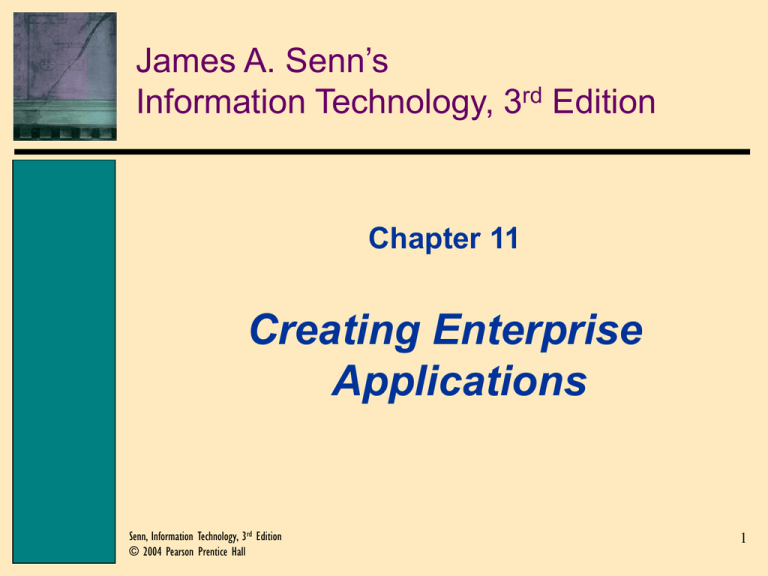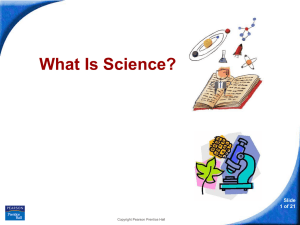
James A. Senn’s
Information Technology, 3rd Edition
Chapter 11
Creating Enterprise
Applications
Senn, Information Technology, 3rd Edition
© 2004 Pearson Prentice Hall
1
Objectives
• Describe the principal functions and roles of a
system analyst.
• Identify the characteristics of shared systems.
• Discuss the changing process for developing
information systems applications.
Senn, Information Technology, 3rd Edition
© 2004 Pearson Prentice Hall
2
Objectives (Continued)
• Describe the tools and techniques available to
system analysts for collecting data and
developing IT applications.
• Summarize the purpose and characteristics of
unified modeling language (UML).
• Explain the roles of the four types of IT
systems development professionals.
Senn, Information Technology, 3rd Edition
© 2004 Pearson Prentice Hall
3
Developing Open Shared Systems
Development Alternatives
• Build the application itself.
• Purchase a prewritten application.
• Contract out the application development.
Senn, Information Technology, 3rd Edition
© 2004 Pearson Prentice Hall
4
Developing Open Shared Systems
Open Systems for Sharing
• Open System: A software system that performs
on different computer and communications
hardware.
• Interoperability: The perfect exchange of data
and information in all forms (data, text, sound,
and image, including animation) between the
individual components of an application
(hardware, software, network).
Senn, Information Technology, 3rd Edition
© 2004 Pearson Prentice Hall
5
Developing Open Shared Systems
Shifting Development Model
• Craft Approach
• Assembly Approach
• Object: A component that contains data about
itself and how it is to be processed.
Senn, Information Technology, 3rd Edition
© 2004 Pearson Prentice Hall
6
Developing Open Shared Systems
Building IT with Components
Senn, Information Technology, 3rd Edition
© 2004 Pearson Prentice Hall
7
The System Analyst’s Tools and
Techniques
Definition
• Systems Analyst: The IT professional
responsible for working with users to
determine a system’s requirements and for
describing the features needed in the system.
Senn, Information Technology, 3rd Edition
© 2004 Pearson Prentice Hall
8
The System Analyst’s Tools and
Techniques
Data Collection Techniques
• Interviews
– Structured Interview: An interview in which
the questions are prepared in advance and
each interviewee is asked the same set of
questions.
– Unstructured Interview: An interview in
which the questions may be prepared in
advance, but follow-up questions vary,
depending on the interviewees’ background
and answer.
Senn, Information Technology, 3rd Edition
© 2004 Pearson Prentice Hall
9
The System Analyst’s Tools and
Techniques
Data Collection Techniques (Continued)
• Questionnaire: A sheet of questions used to
collect facts and opinions from a group of
people.
• Document Examination/Record Inspection: The
review of company documents about a system
or opportunity under investigation.
• Observation: The process of watching an
activity take place to collect information about
that activity.
Senn, Information Technology, 3rd Edition
© 2004 Pearson Prentice Hall
10
The System Analyst’s Tools and
Techniques
Data Collection Techniques (Continued)
• Sampling: The process of collecting data and
information at prescribed intervals.
Senn, Information Technology, 3rd Edition
© 2004 Pearson Prentice Hall
11
The System Analyst’s Tools and
Techniques
System Flowcharts
• System Flowcharts: A graphical description of
a business process or procedure using
standard symbols to show decision logic.
Senn, Information Technology, 3rd Edition
© 2004 Pearson Prentice Hall
12
The System Analyst’s Tools and
Techniques
System Flowcharts (Continued)
Senn, Information Technology, 3rd Edition
© 2004 Pearson Prentice Hall
13
The System Analyst’s Tools and
Techniques
Dataflow Diagram
• Dataflow Diagram (DFD): A chart showing the
movement of data through a system.
– DFD Levels
• Leveling: The process of exploding
processes in a dataflow diagram to show
more detail.
Senn, Information Technology, 3rd Edition
© 2004 Pearson Prentice Hall
14
The System Analyst’s Tools and
Techniques
Dataflow Diagram (Continued)
Senn, Information Technology, 3rd Edition
© 2004 Pearson Prentice Hall
15
The System Analyst’s Tools and
Techniques
Dataflow Diagram (Continued)
Senn, Information Technology, 3rd Edition
© 2004 Pearson Prentice Hall
16
The System Analyst’s Tools and
Techniques
Data Dictionaries
• Data Dictionary/Repository: A catalog that lists
and describes all the types of data flowing
through a system. Composed of data elements
and a data structure.
• Data Element: The component of a data
dictionary that includes data names, alternate
names, and length allowances.
Senn, Information Technology, 3rd Edition
© 2004 Pearson Prentice Hall
17
The System Analyst’s Tools and
Techniques
Data Dictionaries (Continued)
Senn, Information Technology, 3rd Edition
© 2004 Pearson Prentice Hall
18
The System Analyst’s Tools and
Techniques
Data Dictionaries (Continued)
• Data Structure: The set of data elements used
together and the name that collectively
identifies the set.
Senn, Information Technology, 3rd Edition
© 2004 Pearson Prentice Hall
19
Computed-Aided Systems
Engineering (CASE)
Definition
• Computed-Aided Systems Engineering/Computer-Aided
Software Engineering (CASE): A set of tools used in
systems development to improve the consistency and
quality of the system while automating many of the most
tedious and time-consuming systems tasks.
– Charting and Diagramming Tools
– Centralized Information Repository
– Interface Generators
– Code Generators
– Project Management Tools
Senn, Information Technology, 3rd Edition
© 2004 Pearson Prentice Hall
20
Computed-Aided Systems
Engineering (CASE)
Definition (Continued)
Senn, Information Technology, 3rd Edition
© 2004 Pearson Prentice Hall
21
Computed-Aided Systems
Engineering (CASE)
Front-End, Back-End, and Integrated CASE
• Front-End CASE Tool: A CASE tool that
automates the early (front-end) activities in
systems development.
• Back-End CASE Tool: A CASE tool that
automates the later (back-end) activities in
systems development.
• Integrated CASE (I-CASE) Tool: A CASE tool
that spans activities throughout the entire
systems development life cycle.
Senn, Information Technology, 3rd Edition
© 2004 Pearson Prentice Hall
22
Computed-Aided Systems
Engineering (CASE)
Front-End, Back-End, and Integrated
CASE (Continued)
Senn, Information Technology, 3rd Edition
© 2004 Pearson Prentice Hall
23
Unified Modeling Language
Definition
• Unified Modeling Language (UML): The
standard vehicle for visualizing,
describing,and documenting the details of an
IT application.
• Actor: Anyone or anything that will interact
with the application.
• Activity Diagram: Shows the flow of control in
an application.
Senn, Information Technology, 3rd Edition
© 2004 Pearson Prentice Hall
24
Unified Modeling Language
Definition (Continued)
Senn, Information Technology, 3rd Edition
© 2004 Pearson Prentice Hall
25
Unified Modeling Language
Definition (Continued)
• Use Case Diagram: Provides context for the
system, illustrating the actors, the use cases,
and the flow or interaction between use cases
and actors.
– Use Case: Identifies the sequence of
activities performed for an actor.
• Use Case Description: Describes the use case
in ordinary language, including its identifying
name and actors.
Senn, Information Technology, 3rd Edition
© 2004 Pearson Prentice Hall
26
Unified Modeling Language
Definition (Continued)
Senn, Information Technology, 3rd Edition
© 2004 Pearson Prentice Hall
27
Unified Modeling Language
Definition (Continued)
• Class Diagram: Describes an object class,
including the class name, attributes, and
methods.
• Other UML Diagrams
– Sequence Diagram
– State Transition Diagram
– Component Diagram
Senn, Information Technology, 3rd Edition
© 2004 Pearson Prentice Hall
28
Unified Modeling Language
Definition (Continued)
Senn, Information Technology, 3rd Edition
© 2004 Pearson Prentice Hall
29
IT Development Personnel
The Systems Analyst: The Key Roles
• Change Agent: A person who acts as a catalyst
for change.
• Professional Skills
– Problem Solving
– Outcome Thinking
– Creativity
– Meeting Skills
– Communication Skills
Senn, Information Technology, 3rd Edition
© 2004 Pearson Prentice Hall
30
IT Development Personnel
The Systems Analyst: The Key Roles
Senn, Information Technology, 3rd Edition
© 2004 Pearson Prentice Hall
31
IT Development Personnel
The Chief Information Officer
• Chief Information Officer (CIO)/IT
Director/Director of Information Systems: The
person given the responsibility of managing
and developing the firm’s information
technology capabilities.
Senn, Information Technology, 3rd Edition
© 2004 Pearson Prentice Hall
32
IT Development Personnel
The Chief Information Officer (Continued)
Senn, Information Technology, 3rd Edition
© 2004 Pearson Prentice Hall
33
IT Development Personnel
Computer Programmers
• Computer Programmers
– Responsible for turning detailed
specifications into computer software.
– Responsible for documenting the program.
Senn, Information Technology, 3rd Edition
© 2004 Pearson Prentice Hall
34
IT Development Personnel
System Contractors
• System Contractor: An outside person or firm
that contracts with a company to develop IT
applications.
• System Integrator: A type of systems
contractor who is retained to take
responsibility for acquiring hardware, software
and network capacity for an application, as
well as for implementing the application.
Senn, Information Technology, 3rd Edition
© 2004 Pearson Prentice Hall
35






